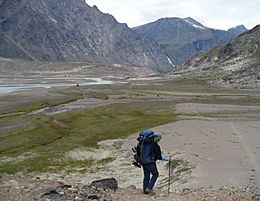Schwartzenbach Falls facts for kids
Quick facts for kids Schwartzenbach Falls |
|
|---|---|
| Qulitasaniakvik | |

Weasel River Valley with Schwartzenbach Falls in the distance
|
|
| Lua error in Module:Infobox_mapframe at line 185: attempt to index field 'wikibase' (a nil value). | |
| Location | Auyuittuq National Park, Nunavut, Canada |
| Coordinates | 66°30′30″N 65°31′30″W / 66.5083°N 65.5250°W |
| Type | Tiered Horsetails |
| Elevation | 640 m (2,100 ft) |
| Total height | 520 m (1,710 ft) |
| Number of drops | 5 |
| Longest drop | 200 m (660 ft) |
| Total width | 30 m (98 ft) |
| Average width | 30 m (98 ft) |
| Run | 884 m (2,900 ft) |
| Watercourse | Unnamed stream |
| Average flow rate |
3 m3/s (110 cu ft/s) |
| World height ranking | 111th |
Schwartzenbach Falls, also called Qulitasaniakvik, is an amazing waterfall in Canada. You can find it in the Weasel River Valley on Baffin Island in Nunavut. This waterfall is a "tiered horsetail" type, which means the water flows down a steep slope while staying in contact with the rock, and it has several levels or steps.
At 520 m (1,710 ft) tall, Schwartzenbach Falls is one of the tallest waterfalls in Canada. It's actually the 4th tallest in the whole country! It's also the tallest waterfall in Canada outside of British Columbia.
What's in a Name?
The local people, the Inuit, have their own name for this waterfall. They call it Qulitasaniakvik. This name comes from the Inuktitut language and means "place to get caribou skins."
This name tells us something important about the area. The valley above the falls was a great spot for hunting caribou. Caribou are a type of deer, and their skins were very useful for clothing and shelter.
How the Falls Are Formed
Schwartzenbach Falls is created by a stream that doesn't have a specific name. This stream plunges 520 m (1,710 ft) down the side of the Weasel River Valley.
The very first part of the waterfall is a huge drop of 200 m (660 ft). The water here flows over a slanted cliff, looking like a "horsetail" as it spreads out. After this big drop, the water continues down through four smaller waterfalls. These cascades drop another 320 m (1,050 ft). Finally, the cliff ends, and the water flows over piles of broken rocks called talus deposits.

